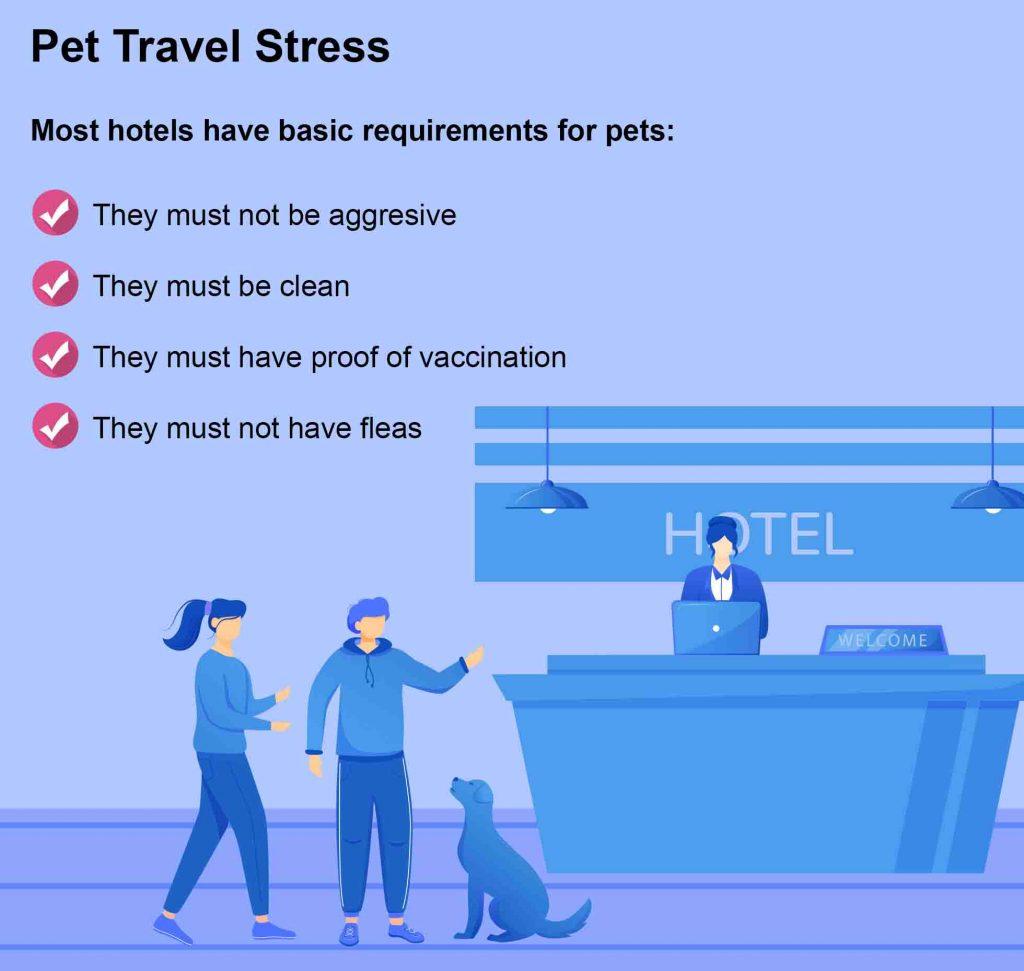
Going to beach, mountains or Paris? Great!
But don’t forget your pet. They may not like it. It’s hard to be apart, but taking them can be harder. Think of their health before deciding.
For pet lovers, that four-legged friend or the furry little cat is an essential member of the family, which means you can’t fully trust someone else to take care of them.
In most cases, traveling with a pet – cat or dog is the only option for avoiding stressful times and worrying about their safety and well-being.
We’ve covered all you need to know about traveling with your pet and finding pet-friendly accommodation.
Guide to Travelling With Pet
Going with pets? Plan well. In cars, put dogs in the back and small pets in carriers. When flying, ask airlines about pet rules and carry a health paper. Talk to your vet about feeding and behavior. Learn about pet travel laws in each place for a smooth trip.
Traveling with a pet in the Car
You must carry your dog in the back seat for safety purposes, properly restrained using a seatbelt. It’s recommended that cats and smaller pets travel in a carrier.
They should also be secured with a seatbelt. The pet travel laws in the U.S. vary per state, with some restricting travel with certain dog breeds.

For example, the law requires that you vaccinate your dog against rabies before traveling.
From the pet vaccination laws to the safety harness guidelines, there are several pet travel laws you would want to consider before scheduling a trip – especially if you’re traveling across different towns or states.
If you own a pet, there are pretty high chances you already know all these laws, but it doesn’t hurt to confirm with the local authorities to be sure you won’t attract a hefty fine when crossing over to the neighboring state or City.
Flying with Your Pet? The Do’s and Don’ts
If you want to fly with your pet, the legal landscape could be slightly different. Here are preparations you can make to ensure flying with your pet is a success:
- Consult the airlines before booking a flight.
- Ask for clarification on the pet restrictions, breed types, and size.
- A few airlines will allow pet birds of particular species.
- Ensure you have a health certificate for your pet. Only healthy pets are allowed on board, and you’re required to produce a health certificate.
- Your pet should be of age. At least two months old.
- Talk to your vet about your pet’s feeding habits, behaviour, and general temperament. It’s recommended to limit your pet’s diet the day before traveling.
- Factors like age, size, dietary needs, and travel distance, should also be considered.
Apart from the basics above, you would want to use some tips below to make the travel more convenient for you and your pet. These include but not limited:
- Give your dog(s) a run, an hour or two before a scheduled trip to exhaust them.
- If your pet is friendly, consider getting a “do not pet” vest, especially for dogs that can get overly excited.
- Get a mat for your dog if it sheds a lot. This will avoid messing up the plane.
- Don’t feed your dog on the plane. Likewise, too much water could make your dog pee a lot. This applies to most pets.
It’s worth noting that a typical pet and an emotional support animal (ESA) are covered separately by travel laws. Recent developments on ESAs on planes could mean stricter rules and regulations that ESA owners would need to adapt.
Until then, an ESA letter is a requirement if you’re to fly with a support animal.
An ESA or a Pet
ESAs differ from Pets in that pets are primarily kept for companionship, while ESAs can be any animal kept for emotional support: a dog, cat, squirrel, bird, pig, and even a reptile.
However, there are those ESAs that are widely accepted and considered more friendly and compassionate than others. For example, certain dog breeds that fit the ESA frame better due to their unique temperament and unconditional love.
Another critical difference between a pet and an ESA is that with the latter, you need a valid ESA letter from licensed medical personnel when traveling or moving to a new apartment (with pet restriction policy).
Guideline to follow for pet safety
For pet safety, consider their well-being before traveling. Dogs can get stressed in new places, and cats dislike change. Consult your vet for advice and consider a pet sitter at home. If taking your pet, know the rules and have their health papers. Avoid cargo holds on planes. If leaving them, choose a trusted friend, kennel, or sitter. Ensure they have a microchip, and provide the sitter with contact details, vet information, and pet needs. Familiarize your pet with the sitter beforehand.
What to do?
Taking your pet with you sounds nice, but not all pets can travel well. Think about their health and happiness first.
Dogs may feel more stressed in a new place. Cats don’t like change. So, it’s better to find a pet-sitter at home. Talk to your vet if you’re unsure about travel. They can help you decide and give advice.
Taking your pet?
Make sure you have what they need and know about any travel rules. Keep their health papers with you. Avoid putting them in a plane’s cargo hold.
Leaving them behind?
Find a trusted friend, kennel, or pet sitter. Check the place and people you choose. Make sure your pet has a microchip.
Give the sitter your contact info, vet’s details, and pet’s needs. Help your pet get used to the sitter before you go.
Choosing a Pet-Friendly Hotel
When choosing a hotel, there are certain things you want to keep in mind. We’ve highlighted some below that will help you make the right choices.
Consider Pet Essentials
Not all hotels will provide some pet essentials such as pet bowls, pet treats, or toys. Traveling with bedding, coats, food, and all the other essentials are already too much, and you need a hotel that can take care of the rest.
For example, a great dog-friendly hotel will offer water bowls and a few pet treats. Others will have dog food and menus for you to choose from.
Your Pet’s Freedom
Depending on the hotel you choose, you can have all the freedom with your pet. This means accessing all the areas such as restaurants and lounges. However, most will limit your pet’s movement within the premises.
This often comes as a requirement to ensure safety for everyone living or visiting the hotel – in case your pet isn’t friendly. More often, dogs will be banned in formal restaurants within the hotel but can be allowed in the bar or lounge areas.
Regardless of the situations, always inquire if there are any specific rules regarding your pet’s freedom. A great pet-friendly hotel will advise you to stay beside your pet at all times, provided it’s friendly and won’t scare or harm strangers.
Any Special Attractions?

Your pet, just like you, would enjoy a modern hotel with some extra playing space or even a nearby park – where the two of you can go for a walk.
This is important if you plan to stay in a given hotel for a few days or weeks.
If you’re travelling with a dog(s), you’ll need to prioritise physical exercise to avoid exposing them to unnecessary stress and potential health issues. If you are keen to inquire more about this, you’ll find some better alternatives instead of settling for any accommodation deal that presents itself.
Do Your Research before travelling with pet
It pays to do your research before traveling to a new place.
You want to go through Google Reviews, ask friends or check popular sites such as TripAdvisor or booking before putting your trust in some new hotel.
Reputation means a lot for a hotel that values their customers and are mindful of the quality they offer to the market. Also, the right pet-friendly hotel won’t overcharge you for walking in with a pet. You’ll incur some extra fees, but that doesn’t mean you’ll have to pay more than you can afford.
The other thing to remember is to check the number of pets your hotel can accommodate per room.
Many times, hotels will specify a given number, above which you’ll be charged an extra fee. To avoid inconveniences, always choose a pet-friendly hotel, and you’re sure they will understand your unique needs.
Wrapping It Up
Traveling with your pet to find a place to accommodate the two of you shouldn’t be a headache. With the above tips, you won’t have to deal with inconveniences such as being overcharged for a hotel room, your pet pooping on the plane, or even worse, finding yourself on the wrong side of the law.
If you are traveling with an ESA instead of a pet, contact us at Ezcare clinic, and we’ll be glad to walk you through the ESA letter application process.
Read also:





